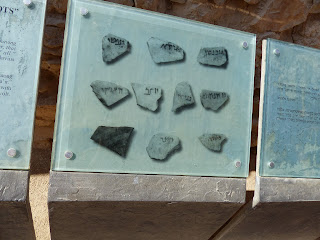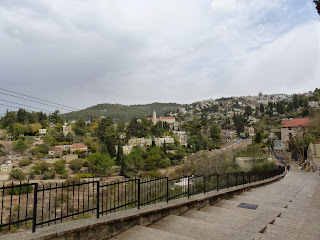Masada (Hebrew for fortress) was the last Jewish stronghold against the Roman invasion in the early 70s A.D. Next to Jerusalem, it is the most popular destination of tourists visiting Israel.
Masada is located atop an isolated rock cliff at the western end of the Judean Desert overlooking the Dead Sea. The natural approaches to the cliff top are very difficult. We took a cable car all the way to the top!
Dead Sea with the mountains of Jordan on the other side. Note the white "trim" around the banks of the Dead Sea? Salt!
On the other side of the Masada fortress . . . desert!
The only written source about Masada is Josephus Flavius’ The Jewish War. Born Joseph ben Matityahu into a priestly family, he called himself Josephus Flavius and became a Roman citizen and a successful historian.
According to Flavius, Herod the Great built the fortress of Masada between 37 and 31 BCE. Herod, an Idumean, had been made King of Judea by his Roman overlords and “furnished this fortress as a refuge for himself.” It included a casemate wall around the plateau, storehouses, large cisterns ingeniously filled with rainwater, barracks, palaces and an armory.
Large cistern for collecting rain water.
Part of Herod's large bathhouse. Below is the double floor of the hypocaust, through which the hot room (caldarium) was heated.
Ancient synagogue.
Catholic pilgrims take a break sitting in the shade of the synagogue.
The ground floor of the columbarium tower below served as a dovecot, a structure intended to house pigeons or doves. Notice the niches in the walls? This is where the doves would roost. The doves supplied meat for the inhabitants of Masada and fertilizer for the agricultural crops.
Large stones manufactured by the Jewish rebels (or Zealots) to be rolled down the hill upon the Romans troops.
Some 75 years after Herod’s death, at the beginning of the Revolt of the Jews against the Romans in 66 CE, a group of Jewish rebels overcame the Roman garrison of Masada. After the fall of Jerusalem and the destruction of the Temple (70 CE) they were joined by zealots and their families who had fled from Jerusalem. There, they held out for three years, raiding and harassing the Romans.
Then, in 73 CE, Roman governor Flavius Silva marched against Masada with the Tenth Legion, auxiliary units and thousands of Jewish prisoners-of-war. The Romans constructed a rampart of thousands of tons of stones and beaten earth against the western approaches of the fortress and, in the spring of 74 CE, moved a battering ram up the ramp and breached the wall of the fortress.
Once it became apparent that the Tenth Legion's battering rams and catapults would succeed in breaching Masada's walls, Elazar ben Yair - the Zealots’ leader - decided that all the Jewish defenders should commit suicide; the alternative facing the fortress’s defenders were hardly more attractive than death.
Flavius dramatically recounts the story told him by two surviving women. The defenders – almost one thousand men, women and children – led by ben Yair, burnt down the fortress and killed each other. The Zealots cast lots to choose 10 men to kill the remainder. They then chose among themselves the one man who would kill the survivors. That last Jew then killed himself.
Pottery shards with Jewish names on them -- most likely the lots that individuals cast to decide who would kill the others in the Masada fortress.





























































